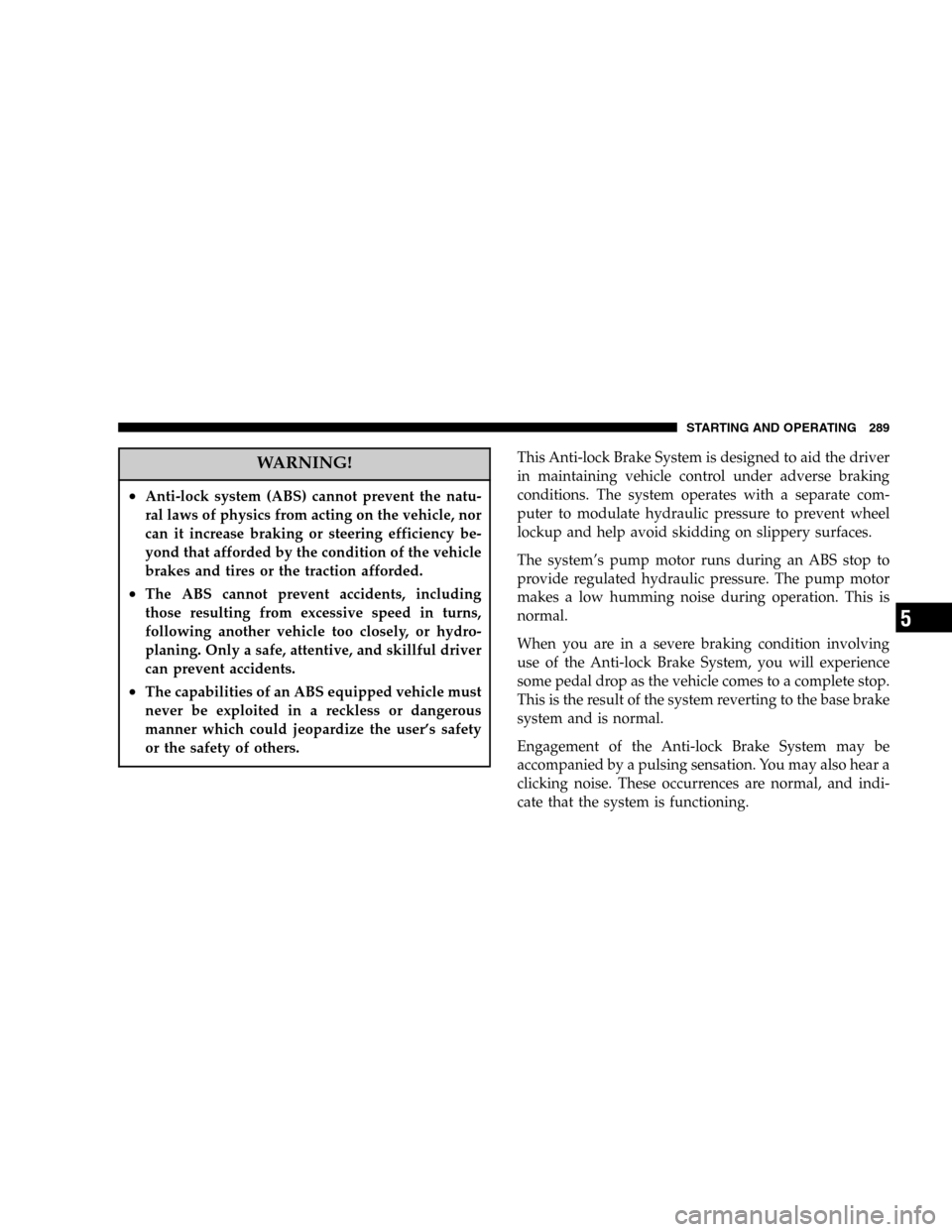Page 72 of 493

Safety Checks You Should Make Inside The Vehicle
Seat Belts
Inspect the belt system periodically, checking for cuts,
frays and loose parts. Damaged parts must be replaced
immediately. Do not disassemble or modify the system.
Seat belt assemblies must be replaced after an accident if
they have been damaged (bent retractor, torn webbing, etc.)
or if the front airbags have deployed. If there is any question
regarding belt or retractor condition, replace the belt.
Airbag Light
The light should come on and remain on for 6 to 8
seconds as a bulb check when the ignition switch is first
turned ON. If the light is not lit during starting, see you
authorized dealer. If the light stays on, flickers or comes
on while driving, have the system checked by an autho-
rized dealer. If there is a problem with the airbag light the
seatbelt light will flash.
Safety Checks You Should Make Outside The Vehicle
Tires
Examine tires for tread wear or uneven wear patterns.
Check for stones, nails, glass or other objects lodged in
the tread.
Inspect for tread cuts or sidewall cracks. Check wheel
nuts for tightness and tires for proper pressure.
Lights
Check the operation of all exterior lights. Check turn
signal and high beam indicator lights on the instrument
panel.
Door Latches
Check for positive closing, latching and locking.
Fluid Leaks
Check area under vehicle after overnight parking for fuel,
water, oil, or other fluid leaks. Also, if fuel fumes are
detected the cause should be located and corrected.
72 THINGS TO KNOW BEFORE STARTING YOUR VEHICLE
Page 248 of 493

▫Operating Precautions..................264
▫Cooling System Tips —
Automatic Transmission................264
�Transmission Shifting....................266
▫Automatic Transmission With Overdrive—
If Equipped.........................266
▫Manual Transmission — 6-Speed —
If Equipped.........................272
�Four-Wheel- Drive Operation — If Equipped . . . 273
▫Manually Shifted Transfer Case Operating
Information/Precautions................273
▫Shifting Procedure - Manually Shifted
Transfer Case........................276
▫Transfer Case Reminder Light............277▫Electronically Shifted Transfer Case Operating
Information/Precautions–If Equipped.......278
▫Shifting Procedure - Electronically Shifted
Transfer Case........................282
�Limited-Slip Differential — If Equipped.......285
�Parking Brake.........................286
�Brake System..........................287
▫Brake Noise.........................288
▫Four-Wheel Anti-Lock Brake System........288
�Power Steering........................290
�Tire Safety Information...................291
▫Tire Markings........................291
▫Tire Identification Number (TIN)..........295
▫Tire Loading And Tire Pressure...........296
248 STARTING AND OPERATING
Page 249 of 493

�Tires—General Information................300
▫Tire Pressure.........................300
▫Tire Inflation Pressures.................301
▫Radial-Ply Tires......................303
▫Compact Spare Tire — If Equipped.........304
▫Limited Use Spare — If Equipped.........305
▫Tire Spinning........................305
▫Tread Wear Indicators..................306
▫Life Of Tire.........................307
▫Replacement Tires.....................307
▫Alignment And Balance.................308
�Supplemental Tire Pressure Information –
If Equipped...........................309�Tire Chains...........................309
�Snow Tires...........................311
�Tire Rotation Recommendations............311
▫Dual Rear Wheels.....................313
�Engine Runaway.......................314
�Fuel Requirements......................314
▫Adding Fuel.........................315
▫Bulk Fuel Storage.....................316
▫Fuel Specifications....................317
�Adding Fuel — 24–Valve Cummins
Turbo Diesel..........................318
�Vehicle Loading........................319
▫Certification Label.....................319
STARTING AND OPERATING 249
5
Page 275 of 493

NOTE:Delayed shifts out of four-wheel drive may be
experienced due to uneven tire wear, low or uneven tire
pressures, excessive vehicle loading, or cold tempera-
tures.
WARNING!
You or others could be injured if you leave the
vehicle unattended with the transfer case in the
Neutral (N) position without first fully engaging the
parking brake. The transfer case Neutral (N) position
disengages both the front and rear driveshafts from
the powertrain and will allow the vehicle to move
regardless of the transmission position. The parking
brake should always be applied when the driver is
not in the vehicle.
For additional information on the appropriate use of each
transfer case mode position see the information below:
2H
Rear Wheel Drive High Range - Normal street and
highway driving. Dry hard surfaced roads.
4H
4-Wheel-Drive High Range - Locks the front and rear
driveshafts together. Forces the front and rear wheels to
rotate at the same speed. Additional traction for loose,
slippery road surfaces only.
N
Neutral - Disengages both the front and rear driveshafts
from the powertrain. To be used for flat towing behind
another vehicle. See Recreational Towing for more infor-
mation.
STARTING AND OPERATING 275
5
Page 289 of 493

WARNING!
•Anti-lock system (ABS) cannot prevent the natu-
ral laws of physics from acting on the vehicle, nor
can it increase braking or steering efficiency be-
yond that afforded by the condition of the vehicle
brakes and tires or the traction afforded.
•The ABS cannot prevent accidents, including
those resulting from excessive speed in turns,
following another vehicle too closely, or hydro-
planing. Only a safe, attentive, and skillful driver
can prevent accidents.
•The capabilities of an ABS equipped vehicle must
never be exploited in a reckless or dangerous
manner which could jeopardize the user’s safety
or the safety of others.
This Anti-lock Brake System is designed to aid the driver
in maintaining vehicle control under adverse braking
conditions. The system operates with a separate com-
puter to modulate hydraulic pressure to prevent wheel
lockup and help avoid skidding on slippery surfaces.
The system’s pump motor runs during an ABS stop to
provide regulated hydraulic pressure. The pump motor
makes a low humming noise during operation. This is
normal.
When you are in a severe braking condition involving
use of the Anti-lock Brake System, you will experience
some pedal drop as the vehicle comes to a complete stop.
This is the result of the system reverting to the base brake
system and is normal.
Engagement of the Anti-lock Brake System may be
accompanied by a pulsing sensation. You may also hear a
clicking noise. These occurrences are normal, and indi-
cate that the system is functioning.
STARTING AND OPERATING 289
5
Page 292 of 493
•European Metric tire sizing is based on European
design standards. Tires designed to this standard have
the tire size molded into the sidewall beginning with
the section width. The letter�P�is absent from this tire
size designation. Example: 215/65R15 96H
•LT (Light Truck)-Metric tire sizing is based on U.S.
design standards. The size designation for LT-Metric
tires is the same as for P-Metric tires except for the
letters “LT” that are molded into the sidewall preced-
ing the size designation. Example: LT235/85R16.
•Temporary Spare tires are high pressure compact
spares designed for temporary emergency use only.
Tires designed to this standard have the letter “T”
molded into the sidewall preceding the size designa-
tion. Example: T145/80D18 103M.
•High Flotation tire sizing is based on U.S. design
standards and begins with the tire diameter molded
into the sidewall. Example: 31x10.5 R15 LT.
292 STARTING AND OPERATING
Page 294 of 493
EXAMPLE:
Service Description:
95= Load Index
—A numerical code associated with the maximum load a tire can carry.
H= Speed Symbol
—A symbol indicating the range of speeds at which a tire can carry a load corresponding
to its load index under certain operating conditions.
—The maximum speed corresponding to the Speed Symbol should only be achieved un-
der specified operating conditions. (i.e. tire pressure, vehicle loading, road conditions and
posted speed limits).
Load Identification:
�....blank....�= Absence of any text on sidewall of the tire indicates a Standard Load (SL) Tire
Extra Load (XL)= Extra Load (or Reinforced) Tire
Light Load= Light Load Tire
C,D,E= Load range associated with the maximum load a tire can carry at a specified pressure
Maximum Load— Maximum Load indicates the maximum load this tire is designed to carry.
Maximum Pressure— Maximum Pressure indicates the maximum permissible cold tire inflation pressure for this
tire.
294 STARTING AND OPERATING
Page 296 of 493
Tire Loading and Tire Pressure
Tire Placard Location
NOTE:The proper cold tire inflation pressure is listed
on either the face of the driver’s door or the driver’s side
“B” pillar.
Tire and Loading Information Placard
This placard tells you important information about
the:
1) number of people that can be carried in the vehicle
2) the total weight your vehicle can carry
Tire Placard Location
Tire and Loading Information
296 STARTING AND OPERATING